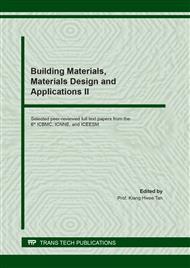[1]
R. Pierrehumbert: There is no Plan B for dealing with the climate crisis, Bull. At. Sci., pp.1-7, Aug. (2019).
Google Scholar
[2]
E. Kiyoshi, Prediction equation of drying shrinkage of concrete based on composite model,, Cement and concrete research, vol. 35, pp.483-493, Mar. (2005).
DOI: 10.1016/j.cemconres.2004.08.002
Google Scholar
[3]
S.Takahiro, Hydration-microstructural evolution and drying shrinkage of Portland cement-blast furnace slag system,, J. Struct Constr. Eng. AIJ, vol.75 No.652, pp.1029-1037, Jun. (2010).
DOI: 10.3130/aijs.75.1029
Google Scholar
[4]
P. Subpa-asa et al, Study on the Influence of Blast Furnace Slag on Chloride Ion Penetration Property,, 2020 IOP Conf. Ser.: Mater. Sci. Eng. 840 012014.
DOI: 10.1088/1757-899x/840/1/012014
Google Scholar
[6]
P. Jariyathitipong, Resistance to freezing and thawing on concrete with blast furnace slag under chloride attack environment,, Cement Science and Concrete Technology vol. 67, p.427. (2014).
DOI: 10.14250/cement.67.427
Google Scholar
[7]
Nippon Slag Association.: Iron and Steel Slag Statistics (2015), pp.1-7.
Google Scholar
[8]
A. Antonio, A Maria, R Wellington, Drying and autogenous shrinkage of pastes and mortars with activated slag cement,, Cement and concrete research, vol 38, pp.565-574, Nov. (2008).
DOI: 10.1016/j.cemconres.2007.11.002
Google Scholar
[9]
K. Takehashi, K Watanabe, K Niitani, K Hosotani, Effect of Blast Furnace Slag Fine Aggregate for Freezing and Thawing Durability of Mortar and Concrete under Salt Existence Environment,, Japan Society Concrete Engineering, vol. 66, p.51 Mar. (2014).
Google Scholar
[10]
J. Thitipong, Improvement of resistance to sulfuric acid attack of concrete by use of blast furnace slag sand,, Materials and Concrete Structures. J. Jpn. Soc. Civil Eng vol. 69, pp.337-347. (2013).
Google Scholar
[11]
T. Fujii, Resistance to freezing and thawing attack of concrete with blast furnace slag fine aggregate,, Materials and Concrete Structures. J. Jpn. Soc. Civil Eng, vol.70, pp.417-427. (2014).
DOI: 10.2208/jscejmcs.70.417
Google Scholar
[12]
I. Takeshi, Properties of Concrete Using a Large Amount of Ground Granulated Blast Furnace Slag,, Japan Concrete Engineering Society, vol. 68, pp.10-15. (2014).
Google Scholar
[13]
Subcommittee on Concrete and Materials, Durability of concrete,, Bangkok: Jod Thong Co., Ltd.; (2000).
Google Scholar
[14]
N. Nakamura, Durability of concrete using blast furnace granulated slag,, Concrete engineering annual papers No.11.
Google Scholar
[15]
F. Hogan, The Effect of Blast Furnace Slag Cement on Alkali Aggregate Reactivity,, Cement, Concrete and Aggregates, vol.7, No.2, pp.100-107. (1985).
DOI: 10.1520/cca10377j
Google Scholar
[16]
JIS R 5201 Physical testing methods of cement. (Trans Japanese Stands Association),, Japanese Industrial Standards Committee Standards board, Technical Committee on Civil Engineering, Japan, (2010).
Google Scholar
[17]
JSCE-G571-2003 Test method for effective diffusion coefficient of chloride ion in concrete by migration., Japan Society of Civil Engineers, (2003).
Google Scholar
[18]
JIS R 5202: 2010 Methods for chemical analysis of cement (Trans Japanese Stands Association, Japan), Japanese Industrial Standards Committee Standards board, Technical Committee on Civil Engineering, Japan, (2010).
Google Scholar


